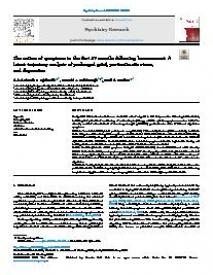The course of symptoms in the first 27 months following bereavement : A latent trajectory analysis of prolonged grief, posttraumatic stress, and depression
Background
Much remains unknown about the course of grief in the early months following bereavement, including the prevalence and timing of a recovery trajectory, whether specific symptoms mark a failure to recover, and the co-occurrence of chronic prolonged grief (PG), posttraumatic stress (PTS) and depression symptoms.
Methods
Two hundred fifty-nine participants completed PG, PTS and depression questionnaires up to eleven times every six weeks during the two years post-bereavement. We used Latent Class Growth Mixture Modeling (LCGMM) to identify subgroups of bereaved individuals sharing similar trajectories for each disorder. We used repeated measures ANOVA to evaluate differences in individual symptoms between trajectories. Finally, we investigated to what extent chronic trajectories of these three disorders co-occurred.
Results
Three trajectories of PG symptoms emerged: resilient (66.4%), chronic (25.1%) and acute recovery (8.4%). The overall severity and symptom profile of the acute recovery group were indistinguishable from that of the chronic group through 6 months post-bereavement, followed by reduction in PG from 6 to 18 months post-bereavement. Chronic PTS in the first-year post-bereavement tended to co-occur with chronic PG and/or chronic depression.
Conclusions
Twenty five percent of those with initial elevations in grief recovered in the period of 6 to 12 months post-bereavement. These findings highlight the clinical importance of severe grief in the initial months following loss, but also suggests caution in diagnosing a grief disorder within the first-year post-bereavement.
Highlights
• Three subgroups of grief trajectories emerged: resilient (66.4%), chronic (25.1%) and an acute recovery trajectory (8.4%).
• This study highlights the clinical importance of severe grief in the initial months for later mental health problems among bereaved individuals.
• This study suggests caution in diagnosing a grief disorder within the first-year post-bereavement.
In: Psychiatry Research ; ISSN: 0165-1781 | 311 | may | 114472
https://doi.org/10.1016/j.psychres.2022.114472


